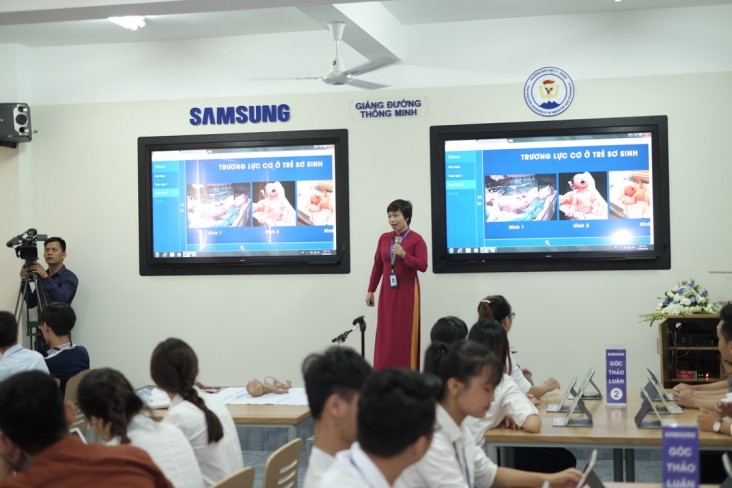
January 2017—Standing in front of nearly 100 students, Dr. Nguyen Thi Binh of the faculty of the Thai Nguyen University of Medicine and Pharmacy faces a significant challenge—she must convey complex material about obstetrics to third-year general medical students, but the barriers to active learning are significant. She worries that her students will come away from her class with adequate knowledge but limited ability to apply that knowledge in real-life medical situations.
She wants to engage her students in discussions and to have interaction with and between students but the lecture room is large and crowded. Students sit in row after row with pen in hand, transcribing her every word.
As the health needs of Vietnam have changed, medical universities in Vietnam have faced challenges in training a health workforce that can respond to the needs of the population now dealing with the threats of chronic and emerging illnesses. This is particularly the case in rural, mountainous and other underserved areas. Facilities, curriculum and teaching approaches in medical universities are often based on outdated concepts of teaching and learning. Classes are often held in large group lectures with minimal use of modern learner-focused techniques known to be most effective.
Launched in 2016, the Improving Access, Curriculum and Teaching in Medical Education and Emerging Diseases (IMPACT MED) Alliance, supported by USAID, has collaborated with private sector partners, the Vietnam Ministry of Health, and Vietnamese universities of medicine and pharmacy to improve medical education by giving graduates the skills and knowledge to address the country’s health challenges.
Last September, alliance partners Samsung and the Partnership for Health Advancement in Vietnam collaborated to improve conditions for active learning at the Thai Nguyen University of Medicine and Pharmacy. Samsung supported the redesign of a classroom into a “smart” classroom, which includes the addition of interactive and interconnected smart boards and tablets. To complement the classroom redesign, the Partnership for Health Advancement in Vietnam provides training and technical support to the university’s faculty in course design and new interactive, learner-focused teaching methods.
In the newly designed classroom, Binh can now integrate multimedia, clicker questions, and other interactive tools into her lecture to better engage her students. In the future, with additional training and technical support from the project, she looks forward to providing her students with the highest quality medical education.
“The combination of smart classrooms with modern facilities and team-based learning is a new experience in our university’s learning and teaching,” said professor Nguyen Van Son, president of the Thai Nguyen University of Medicine and Pharmacy. “This model was applied by many universities in the world. We hope our students will benefit from these new approaches to learning. This is a great start to our curriculum reform efforts and will be a motivation for TUMP faculty and leaders to continue our education reform.”
An additional smart classroom was also launched in 2016 at Ho Chi Minh University of Medicine and Pharmacy. Together, these facilities will impact thousands of medical students each year.
In addition to Samsung, private sector partners of the IMPACT MED Alliance include Johnson & Johnson Vietnam, Bravo!, GE, Roche Diagnostics, 3M, Microsoft, and CLAS Healthcare. The alliance ends in 2021.
LINKS
Follow @USAIDVietnam, on Facebook, on Flickr, on YouTube







Comment
Make a general inquiry or suggest an improvement.